 Waterloo 2022: prelude only really came about because I live on the Isle of Man. My much anticipated Waterloo tour officially starts in London with dinner on 1st September, but given the unpredictable nature of travel these days, I was absolutely determined not to risk a major delay. Accordingly I found myself in London with a whole day to spare yesterday.
Waterloo 2022: prelude only really came about because I live on the Isle of Man. My much anticipated Waterloo tour officially starts in London with dinner on 1st September, but given the unpredictable nature of travel these days, I was absolutely determined not to risk a major delay. Accordingly I found myself in London with a whole day to spare yesterday.
Some people – those with sense – would have found something relaxing to do ahead of what is likely to be an energetic tour. I decided the best way to spend the day was on a marathon tour around the navy museums in Greenwich, before going for dinner with some of my fellow travellers. I was absolutely shattered but had a great deal of fun.
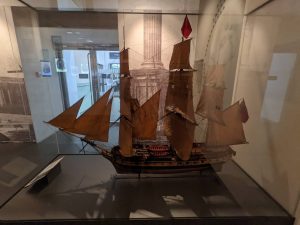 The National Maritime Museum part of Royal Museums Greenwich, a network of museums in the Maritime Greenwich World Heritage Site. Greenwich has always had connections with the sea and navigation. There was a Roman landing place here, the Navy has a long history with the Greenwich waterfront and in 1675, Charles II founded the Royal Observatory for “finding the longitude of places” Greenwich has been the home of Greenwich Mean Time and the Prime Meridian since 1884, and has been a centre for astronomical study. Navigators right across the world have set their clocks according to its time of day. It’s the perfect place for a maritime museum.
The National Maritime Museum part of Royal Museums Greenwich, a network of museums in the Maritime Greenwich World Heritage Site. Greenwich has always had connections with the sea and navigation. There was a Roman landing place here, the Navy has a long history with the Greenwich waterfront and in 1675, Charles II founded the Royal Observatory for “finding the longitude of places” Greenwich has been the home of Greenwich Mean Time and the Prime Meridian since 1884, and has been a centre for astronomical study. Navigators right across the world have set their clocks according to its time of day. It’s the perfect place for a maritime museum.
The Museum has a fantastic collection on the history of Britain at sea including both British and Dutch maritime art, cartography, manuscripts ship models and plans, scientific and navigational instruments. There are a series of galleries looking at the history of Britain at sea, organised either geographically or by historic period.
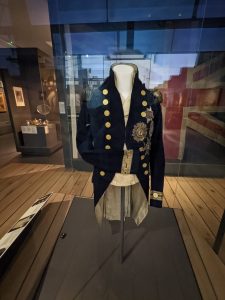 There is, as usual, an abundance of information and artefacts about Lord Nelson, England’s most feted naval hero including the clothing he was wearing when he was shot down on the deck of the Victory during the Battle of Trafalgar. While I’m grateful that the national obsession with Nelson means that EVERY navy museum has something relating to my period of interest, I can’t help imagining the howls of indignation of a few other navy officers of the era who really did some quite impressive stuff themselves, but don’t get a mention. Nevertheless, the National Maritime Museum is fascinating, with loads to see and do for both adults and children and I highly recommend it.
There is, as usual, an abundance of information and artefacts about Lord Nelson, England’s most feted naval hero including the clothing he was wearing when he was shot down on the deck of the Victory during the Battle of Trafalgar. While I’m grateful that the national obsession with Nelson means that EVERY navy museum has something relating to my period of interest, I can’t help imagining the howls of indignation of a few other navy officers of the era who really did some quite impressive stuff themselves, but don’t get a mention. Nevertheless, the National Maritime Museum is fascinating, with loads to see and do for both adults and children and I highly recommend it.
Close by is the old Royal Naval College, the centrepiece of what has come to be known as Maritime Greenwich. The buildings were originally built as the Royal Hospital for Seamen at Greenwich, first chartered by King William III and Queen Mary II in 1694. The buildings were designed by Christopher Wren and built between 1696 and 1712. The hospital closed in 1869 and between 1873 and 1998 it was the Royal Naval College, Greenwich.
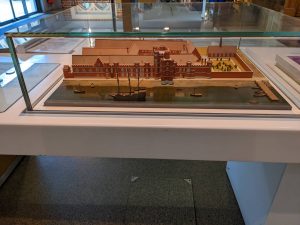
There had been a palace on this site from the days of Humphrey, Duke of Gloucester. It was rebuilt by Henry VII and became known as Greenwich Palace, a favourite residence of several Tudor monarchs. Henry VIII, Mary I and Elizabeth I were all born there. It remained a royal palace until it fell into disrepair during the Civil Wars of the seventeenth century and was finally demolished in 1694.
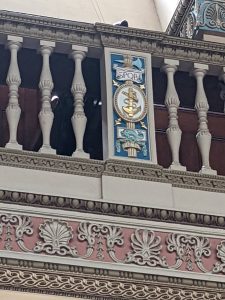 Greenwich Seaman’s Hospital was built on the orders of Mary II who was affected by the sight of wounded sailors coming home from the Battle of La Hogue. It is incredibly beautiful architecturally and both the Chapel and the Painted Hall are well worth a visit. I particularly liked the Chapel, which has naval motifs incorporated into the design.
Greenwich Seaman’s Hospital was built on the orders of Mary II who was affected by the sight of wounded sailors coming home from the Battle of La Hogue. It is incredibly beautiful architecturally and both the Chapel and the Painted Hall are well worth a visit. I particularly liked the Chapel, which has naval motifs incorporated into the design.

Even so, I will admit that for me the most exciting part of that visit was to spot a bust of Admiral Sir Richard Keats, looking benignly at me from a corner. Keats is a recurring character in my Manxman series and it was like running into an old friend, though I probably confused the rest of the tour group with my enthusiasm. Nobody had heard of him and I promise I only gave a gratuitous chunk of information in revenge for somebody asking me if he would have known Nelson…

There’s a modern visitor centre which is really interesting on the subject of the early history of the Greenwich site, including models of the the old palace and the tilt yard established there by Henry VIII.
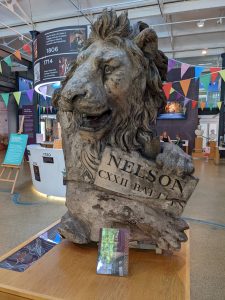 Nelson also features a fair bit, surprisingly enough. England’s Hero lay in state for several days in the Painted Hall and there is a small dedicated Nelson Room, but my favourite artefact is a lion which was apparently a model piece for the Nelson frieze. The lion is holding a stone which purports to claim that Nelson fought in 122 battles. I had this piece of information from the guide and I’ve not managed to check it at all, but my extensive reading on the subject of the Napoleonic navy so far has suggested that most of the time was spent either on tedious blockade duty or seething at home on half-pay. Nobody seemed able to answer my question about how Nelson managed to see quite so much action during his time in the navy but if I get to the bottom of it, I’ll let you know. Alternatively, if anybody else knows where I can find a list of these battles, I’d love to hear it. Nice lion, though.
Nelson also features a fair bit, surprisingly enough. England’s Hero lay in state for several days in the Painted Hall and there is a small dedicated Nelson Room, but my favourite artefact is a lion which was apparently a model piece for the Nelson frieze. The lion is holding a stone which purports to claim that Nelson fought in 122 battles. I had this piece of information from the guide and I’ve not managed to check it at all, but my extensive reading on the subject of the Napoleonic navy so far has suggested that most of the time was spent either on tedious blockade duty or seething at home on half-pay. Nobody seemed able to answer my question about how Nelson managed to see quite so much action during his time in the navy but if I get to the bottom of it, I’ll let you know. Alternatively, if anybody else knows where I can find a list of these battles, I’d love to hear it. Nice lion, though.
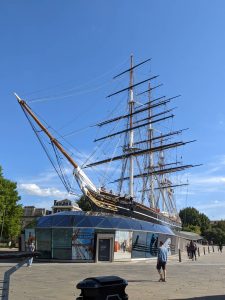 My final visit of the day was to the Cutty Sark, a nineteenth century tea clipper located in dry dock on the river bank. The Cutty Sark has a very sentimental place in my heart as it was a favourite place to visit as a child. We used to go to Greenwich a lot, getting the bus from Mile End and then walking through the Victorian foot tunnel under the river. I loved it there, the park and the eclectic market, the little shops, the Queen’s House and the Observatory, the graceful buildings of the Naval College. That much history in one place always set off my very eccentric imagination about the men and women who had lived in these buildings and walked these streets in the past. But the absolute joy for me was the once or twice a year when we were allowed to actually go aboard the Cutty Sark.
My final visit of the day was to the Cutty Sark, a nineteenth century tea clipper located in dry dock on the river bank. The Cutty Sark has a very sentimental place in my heart as it was a favourite place to visit as a child. We used to go to Greenwich a lot, getting the bus from Mile End and then walking through the Victorian foot tunnel under the river. I loved it there, the park and the eclectic market, the little shops, the Queen’s House and the Observatory, the graceful buildings of the Naval College. That much history in one place always set off my very eccentric imagination about the men and women who had lived in these buildings and walked these streets in the past. But the absolute joy for me was the once or twice a year when we were allowed to actually go aboard the Cutty Sark.
In those days, the Cutty Sark wasn’t the only ship on the riverside. She was joined by the Gypsy Moth IV, the yacht in which Sir Francis Chichester became the first person to single-handedly circumnavigate the globe in 1966. The yacht is now on display in the museum at Buckler’s Hard but I can remember visiting her at Greenwich. It was an exciting story and my sister, her interest firmly rooted in the present, loved it but it failed to catch my enthusiasm in the way that the clipper races of the Cutty Sark did.
I wasn’t sure that I’d still feel the same about the Cutty Sark. Certainly the displays aboard ship are very different to my childhood memories, probably because of the enormous amount of conservation work done over the years, especially after the fire of 2007. It’s astonishing that despite everything, 90% of the ship in Greenwich today is original. The ship you see today is mostly the same as when she first carried tea from Shanghai to London and was reopened by Her Majesty The Queen in 2012.

I was amused at how small the Cutty Sark felt to me, after recent visits to the Victory, the Trincomalee and the Warrior. Below decks had nothing like the atmosphere of the Napoleonic ships but once I was on deck again, I suddenly had that same feeling I remember in childhood, gazing awestruck up into her rigging, trying to imagine what it would have been like. The displays were fascinating and I’ve finally found out where the ship’s name came from. But for me, just standing there on the riverside, stepping onto the deck and then walking down into the old foot tunnel brought back memories so vivid I got quite emotional.
After a day on my feet, it was a relief to meet up with some of my fellow travellers at the Royal Horse Guards Hotel, and dinner was great fun. Today has been very restful, with a trip on the river and lunch at the Royal Opera House with Janet, one of my readers whom I’ve chatted to over the past couple of years and who I’ve been dying to meet. I think I’ve recuperated enough to hit the streets of London with Number One London Tours tomorrow to visit Waterloo related sights before heading off to Belgium the following day.
I’ll try to keep up these posts over the trip and share as many photos as I can, though it’s a packed programme so some of it will probably have to wait until I get home again. I’m hoping to learn a lot this week which will help me with the Waterloo book when I finally get to it. It’s getting alarmingly close…
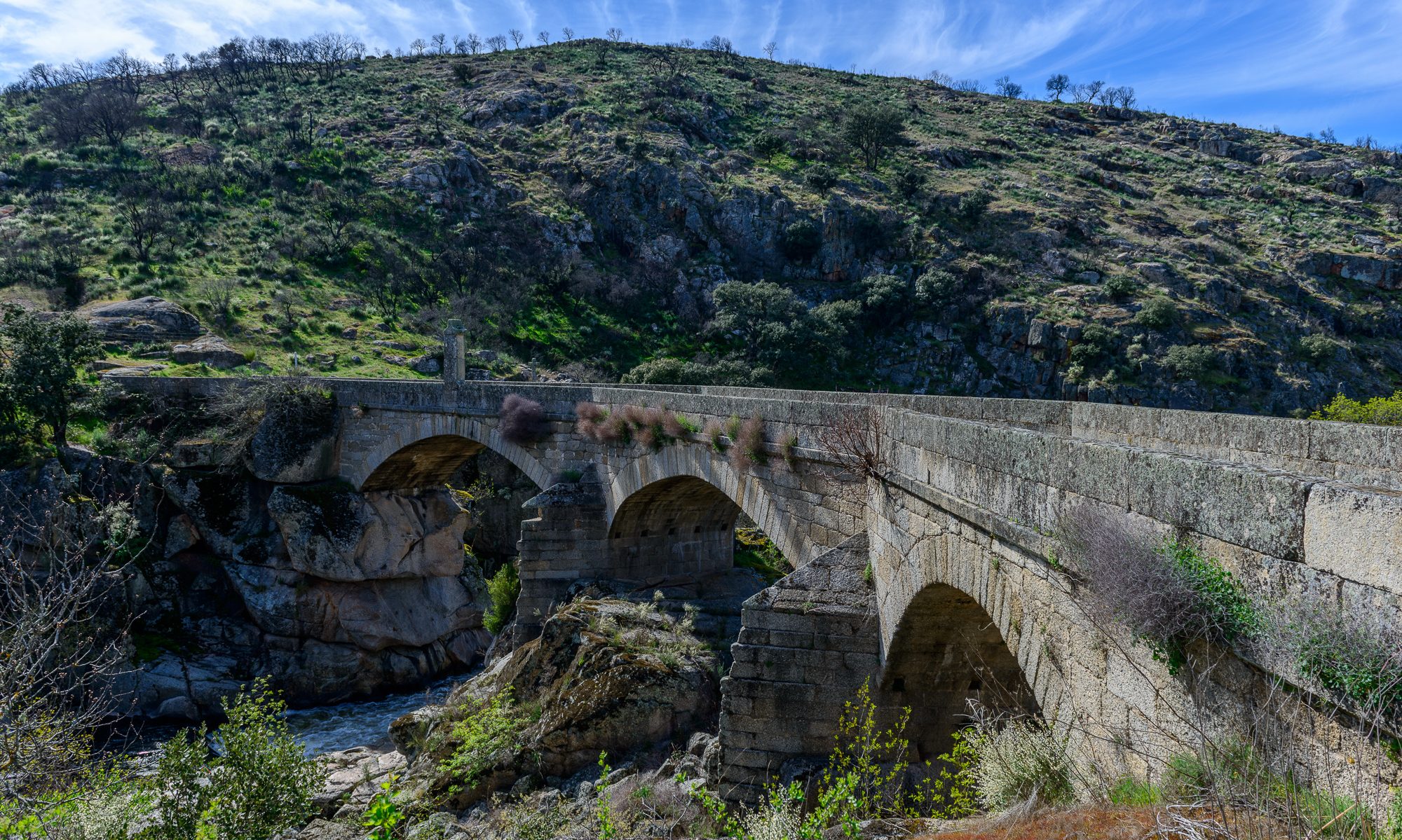


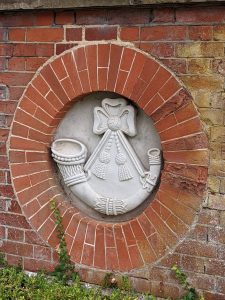 Lynn’s Grand Tour Summer 2022 sounds a lot grander than it really was. I was not in fact meandering through Europe with a fawning retinue and a sketch book, I was simply travelling around England to visit friends and family. Nevertheless, I was away from my island home for more than two weeks, WITHOUT MY DOGS which made it an event worthy of a blog post.
Lynn’s Grand Tour Summer 2022 sounds a lot grander than it really was. I was not in fact meandering through Europe with a fawning retinue and a sketch book, I was simply travelling around England to visit friends and family. Nevertheless, I was away from my island home for more than two weeks, WITHOUT MY DOGS which made it an event worthy of a blog post.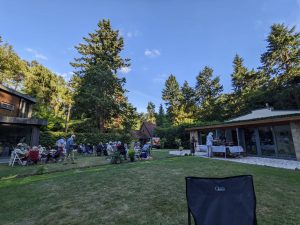 We started off with family, at an outdoor party for my brother-in-law’s 70th birthday. This was an outdoor event and the weather was perfect. Curry and music, dancing on the lawn and then a spectacular firework display to finish was a great start to our trip.
We started off with family, at an outdoor party for my brother-in-law’s 70th birthday. This was an outdoor event and the weather was perfect. Curry and music, dancing on the lawn and then a spectacular firework display to finish was a great start to our trip.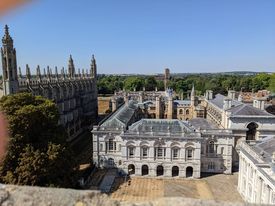 We spent a few days in Nottinghamshire before moving on to Cambridge to stay with my friend Jacqui. The weather, if anything, was too warm but it didn’t stop us from doing a tour of Cambridge. I’ve not been there for many years and it was fabulous to have a tour guide who genuinely loves the city. We went from King’s College to climb the tower of Great St Mary’s which has lovely views over the city.
We spent a few days in Nottinghamshire before moving on to Cambridge to stay with my friend Jacqui. The weather, if anything, was too warm but it didn’t stop us from doing a tour of Cambridge. I’ve not been there for many years and it was fabulous to have a tour guide who genuinely loves the city. We went from King’s College to climb the tower of Great St Mary’s which has lovely views over the city. This was followed by lunch at
This was followed by lunch at 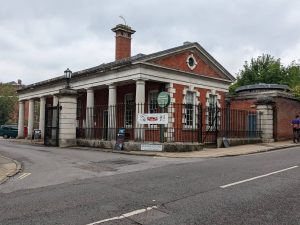 From Cambridge, we moved on to Winchester to visit some old friends who live just outside the city. I love Winchester and it isn’t entirely because of the
From Cambridge, we moved on to Winchester to visit some old friends who live just outside the city. I love Winchester and it isn’t entirely because of the 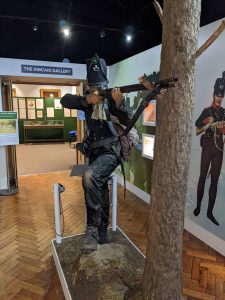
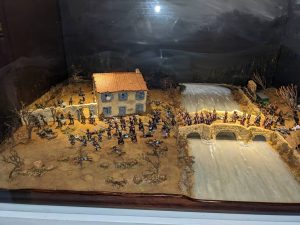
 Winchester is also fairly close to one of my other favourite museums and I was lucky enough to get another fabulously sunny day for a trip to the
Winchester is also fairly close to one of my other favourite museums and I was lucky enough to get another fabulously sunny day for a trip to the 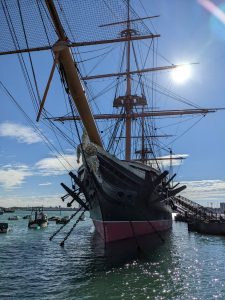
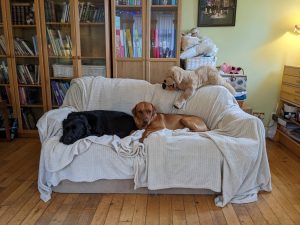 After a visit to London to see my mother-in-law we were finally on our way home. It felt like a very long time since we set off. The dogs went insane when we got home. I’m sure you’ve all seen the online videos of servicemen who have been away for five years being jumped on by their dogs on their return. These don’t impress me, I can get the same result by going to the supermarket. All the same, Oscar and Alfie are delighted I’m back and relieved to be able to settle into their routine again. I daren’t tell them I’m off to Waterloo in just over a week…
After a visit to London to see my mother-in-law we were finally on our way home. It felt like a very long time since we set off. The dogs went insane when we got home. I’m sure you’ve all seen the online videos of servicemen who have been away for five years being jumped on by their dogs on their return. These don’t impress me, I can get the same result by going to the supermarket. All the same, Oscar and Alfie are delighted I’m back and relieved to be able to settle into their routine again. I daren’t tell them I’m off to Waterloo in just over a week…
 Being sixty is an unusual post for me, as it’s not about any of the topics I blog about. People come to Writing with Labradors for my
Being sixty is an unusual post for me, as it’s not about any of the topics I blog about. People come to Writing with Labradors for my 
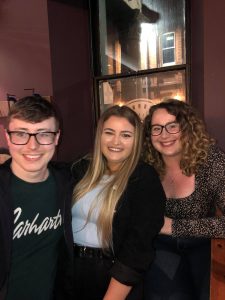 I think attitudes towards age and growing older are very individual. Having three young people in their early twenties living in the same house means I have no chance to become set in my ways. I listen to their music, watch their TV shows and discuss their political views on a daily basis and it wouldn’t occur to me to see that as a bad thing. I’ve had a long and enjoyable life so far but I realise that I still look forward rather than back. I don’t hark back to the good old days. I think change and new ideas and different attitudes are all good for me.
I think attitudes towards age and growing older are very individual. Having three young people in their early twenties living in the same house means I have no chance to become set in my ways. I listen to their music, watch their TV shows and discuss their political views on a daily basis and it wouldn’t occur to me to see that as a bad thing. I’ve had a long and enjoyable life so far but I realise that I still look forward rather than back. I don’t hark back to the good old days. I think change and new ideas and different attitudes are all good for me.
 So what have I done with my 59th year? Well, it’s been an improvement on the previous one in many ways. I managed to get through the Covid lockdowns without getting arrested, which was genuinely a relief. I published three short stories and finally completed book seven of the Peninsular War Saga, which felt like a real achievement after the problems of the previous years. I’ve made a solid start on the third Manxman book and fallen in love with my naval characters all over again.
So what have I done with my 59th year? Well, it’s been an improvement on the previous one in many ways. I managed to get through the Covid lockdowns without getting arrested, which was genuinely a relief. I published three short stories and finally completed book seven of the Peninsular War Saga, which felt like a real achievement after the problems of the previous years. I’ve made a solid start on the third Manxman book and fallen in love with my naval characters all over again.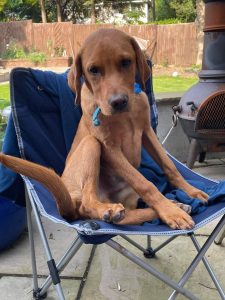 I got a new puppy, a new baby brother for Oscar. No dog could ever replace Toby and Joey in my heart, but Alfie, my little Chaos Demon has found his own place there.
I got a new puppy, a new baby brother for Oscar. No dog could ever replace Toby and Joey in my heart, but Alfie, my little Chaos Demon has found his own place there.  I’ve made contact with one or two old friends and made a promise to do more of this in the year to come. I took myself off on my very own writer’s retreat and enjoyed it so much, I intend to do it again in the coming year.
I’ve made contact with one or two old friends and made a promise to do more of this in the year to come. I took myself off on my very own writer’s retreat and enjoyed it so much, I intend to do it again in the coming year.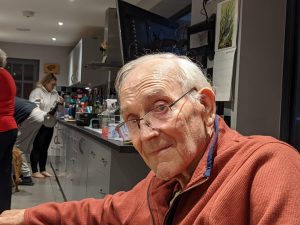 I lost my father-in-law, whom I loved, and organised his funeral. I learned things about families and how difficult it is to get it right. I also learned that sometimes there’s nothing you can do to help and you just have to let go.
I lost my father-in-law, whom I loved, and organised his funeral. I learned things about families and how difficult it is to get it right. I also learned that sometimes there’s nothing you can do to help and you just have to let go.

 NaNoWriMo with Labradors – the first week has gone better than I ever expected. There’s something very motivating about sitting down each day knowing that you’re not going to give up until you’ve at least come close to your word count.
NaNoWriMo with Labradors – the first week has gone better than I ever expected. There’s something very motivating about sitting down each day knowing that you’re not going to give up until you’ve at least come close to your word count. I love writing about Hugh Kelly and Alfred Durrell but in order to be able to tell the full story of the siege of Tarragona I needed men on the ground. As with the storming of Castro Urdiales in
I love writing about Hugh Kelly and Alfred Durrell but in order to be able to tell the full story of the siege of Tarragona I needed men on the ground. As with the storming of Castro Urdiales in 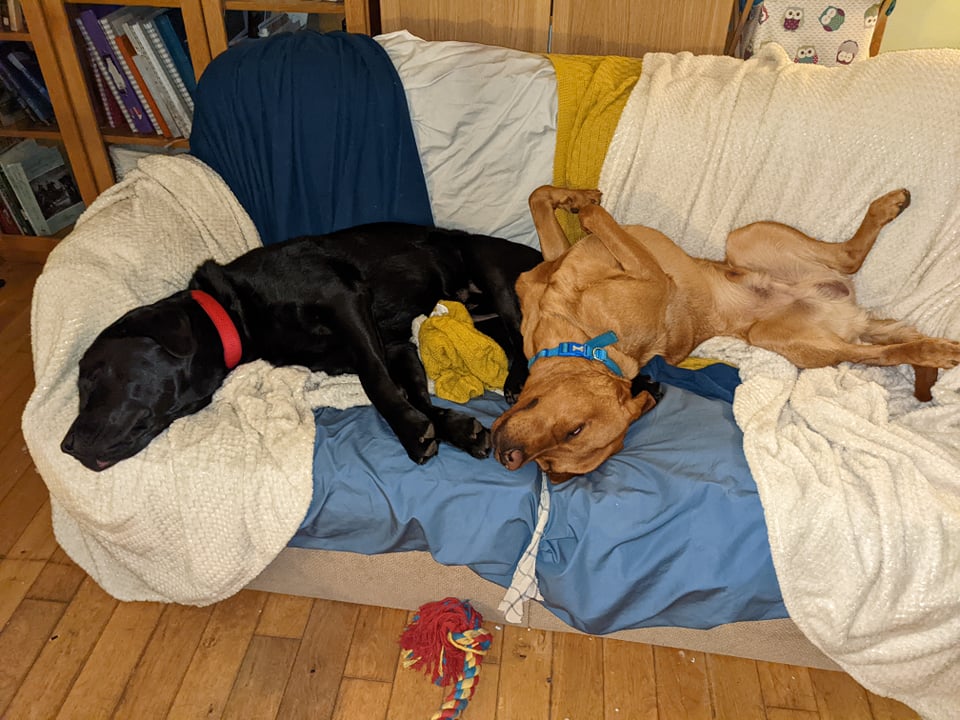
 Hugh turned his attention to his sextant. It was a bright clear day, making the readings easy. Beside him Manby worked out his latitude in a small notebook and there was silence over the group of observers who were suddenly intent on their work. When the master had finished, he walked aft to where Lieutenant Pryce, the officer of the watch waited. Pryce accepted his report of noon along with the degrees and minutes of the latitude observed.
Hugh turned his attention to his sextant. It was a bright clear day, making the readings easy. Beside him Manby worked out his latitude in a small notebook and there was silence over the group of observers who were suddenly intent on their work. When the master had finished, he walked aft to where Lieutenant Pryce, the officer of the watch waited. Pryce accepted his report of noon along with the degrees and minutes of the latitude observed.
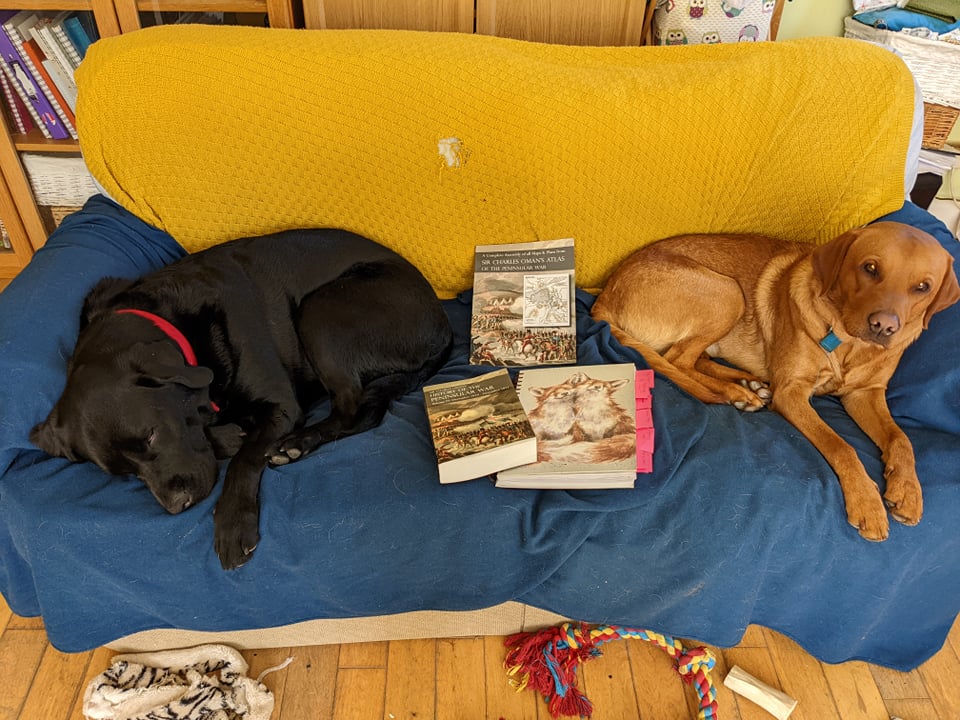 NaNoWriMo with Labradors appeared in my brain when I was trying to get back to sleep at 3.45am. I often struggle with sleep due to back problems, but I do try not to actually think when I’m awake. Thinking is fatal as I have the kind of brain which, once it’s fired up, sets off a series of ideas like a row of fireworks going off. This is really useful when creating fictional plots but a complete pain in the early hours of the morning. Let’s just say I’m going to be tired today.
NaNoWriMo with Labradors appeared in my brain when I was trying to get back to sleep at 3.45am. I often struggle with sleep due to back problems, but I do try not to actually think when I’m awake. Thinking is fatal as I have the kind of brain which, once it’s fired up, sets off a series of ideas like a row of fireworks going off. This is really useful when creating fictional plots but a complete pain in the early hours of the morning. Let’s just say I’m going to be tired today.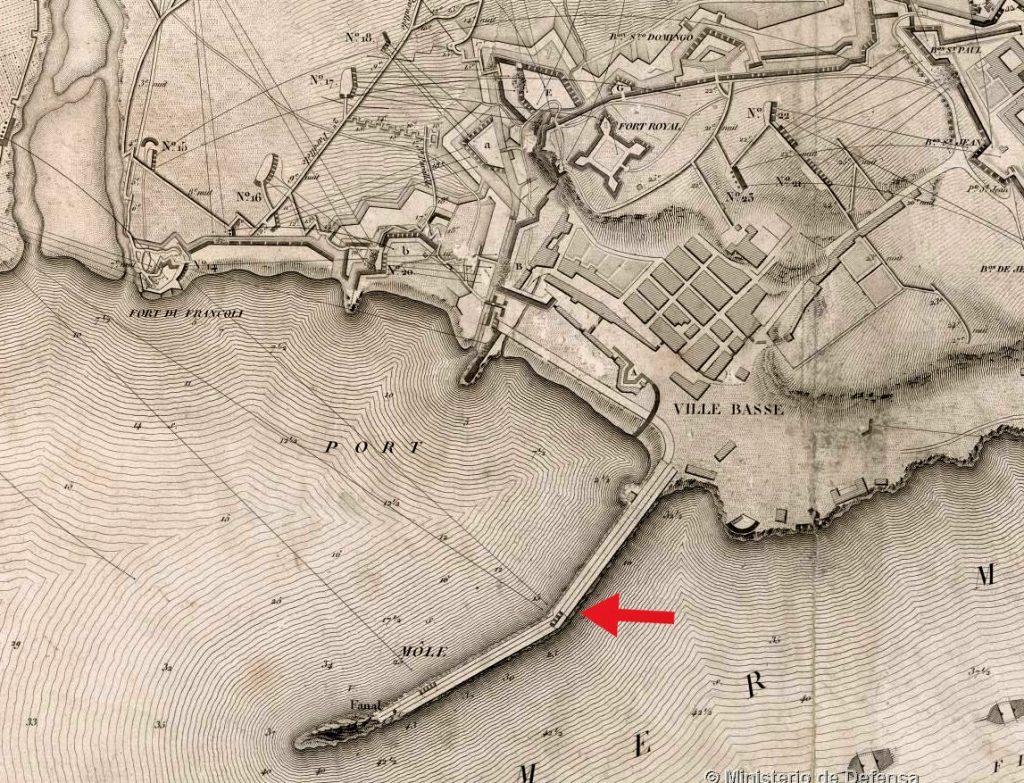 I realised I’d written a lot more of this book than I thought, which was excellent news. Even better, most of it is very good with the exception of the first two chapters which were utterly superfluous to requirements and probably explain why I struggled with this book first time around. I’ve come up with some new ideas, done some more research, invented a useful new character (with major links to the other series, incidentally) and am ready to go.
I realised I’d written a lot more of this book than I thought, which was excellent news. Even better, most of it is very good with the exception of the first two chapters which were utterly superfluous to requirements and probably explain why I struggled with this book first time around. I’ve come up with some new ideas, done some more research, invented a useful new character (with major links to the other series, incidentally) and am ready to go. My notebook is ready, my laptop is fired up and the desk army and navy are ready to offer support. This book is happening people…
My notebook is ready, my laptop is fired up and the desk army and navy are ready to offer support. This book is happening people… 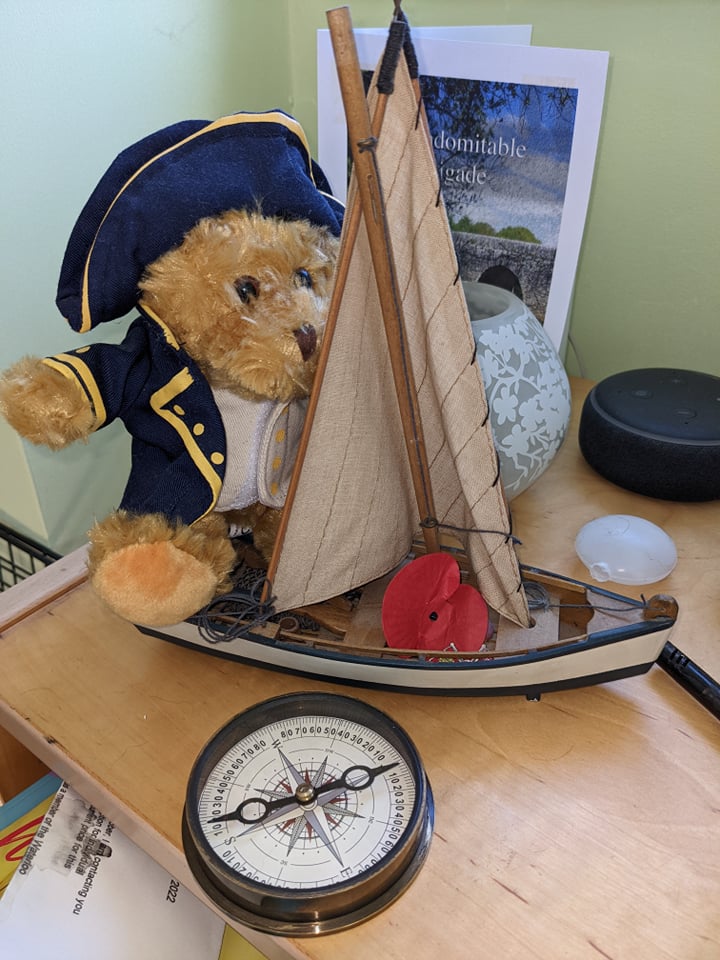
 Oscar and Alfie are excited about this new initiative at Writing With Labradors, as long as it doesn’t interfere with walks, playtime and mealtimes.
Oscar and Alfie are excited about this new initiative at Writing With Labradors, as long as it doesn’t interfere with walks, playtime and mealtimes.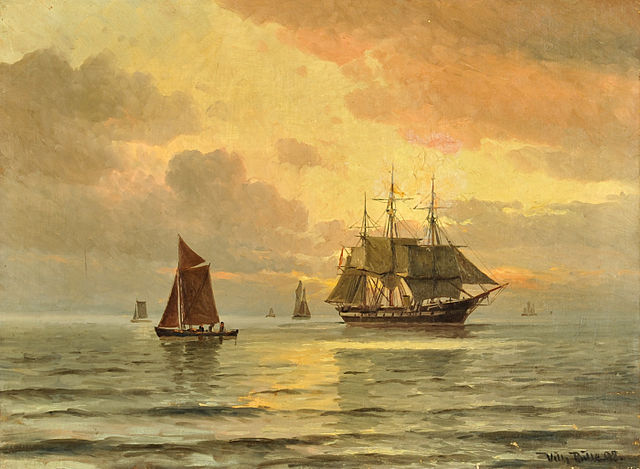 This Bloody Shore: Book 3 of the Manxman series.
This Bloody Shore: Book 3 of the Manxman series.
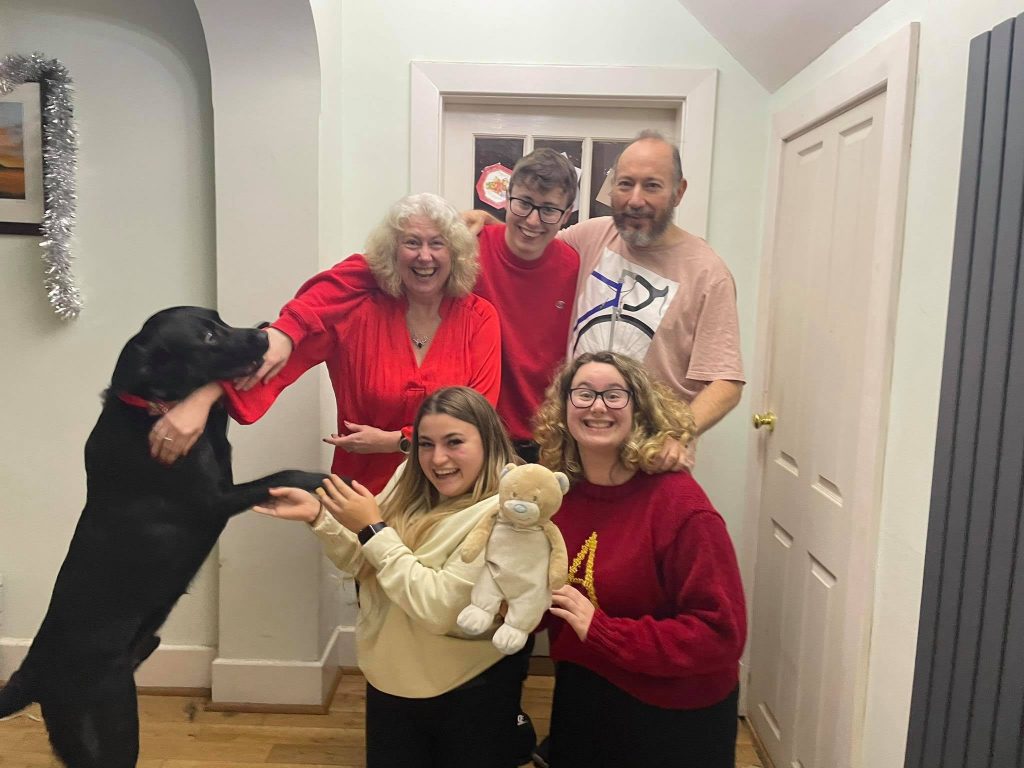 Here comes 2022 at Writing with Labradors, though it’s arriving a little late. Many apologies, and Happy New Year to you all. In many ways, though, the fact that I’m late with my usual New Year’s greeting is in keeping with the whole of the past year. I had such big plans for 2021 and very few of them came to fruition. Mired down in the misery of restrictions, and beset by family difficulties, it’s been a slow year here at Writing with Labradors and at times, I’ve felt like a complete disaster. Still, things are steadily improving and it’s good to look back because it reminds me there have been some highs as well as lows during this year.
Here comes 2022 at Writing with Labradors, though it’s arriving a little late. Many apologies, and Happy New Year to you all. In many ways, though, the fact that I’m late with my usual New Year’s greeting is in keeping with the whole of the past year. I had such big plans for 2021 and very few of them came to fruition. Mired down in the misery of restrictions, and beset by family difficulties, it’s been a slow year here at Writing with Labradors and at times, I’ve felt like a complete disaster. Still, things are steadily improving and it’s good to look back because it reminds me there have been some highs as well as lows during this year. #High. Once I could travel to the UK, I organised my very own
#High. Once I could travel to the UK, I organised my very own 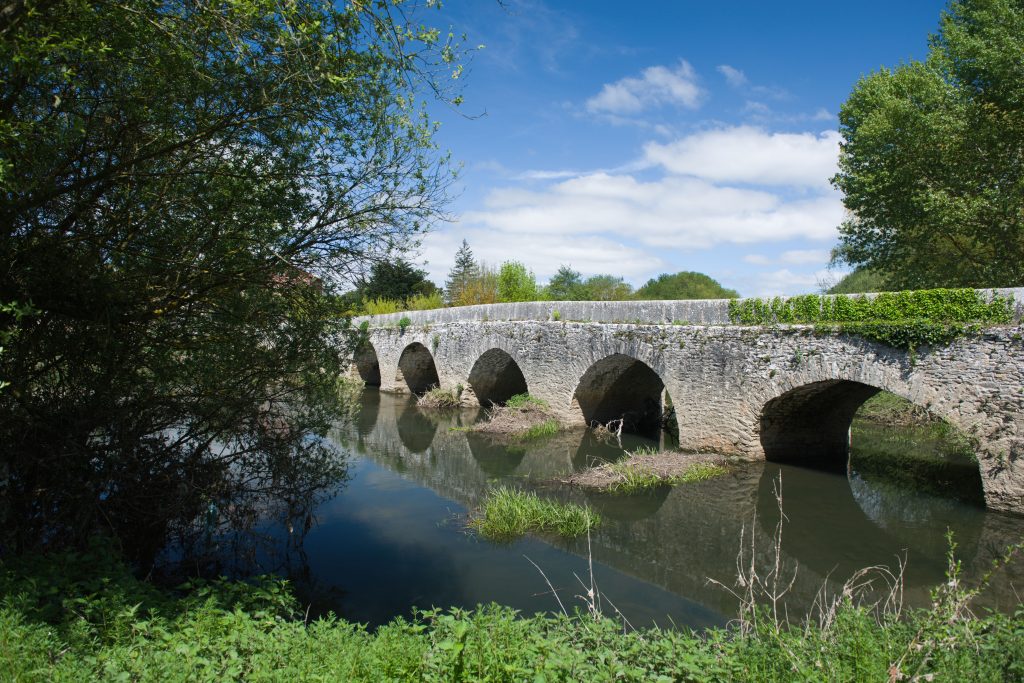 #High. I finished book 7 of the
#High. I finished book 7 of the  #High. For the first time I have published a short story in an anthology.
#High. For the first time I have published a short story in an anthology. 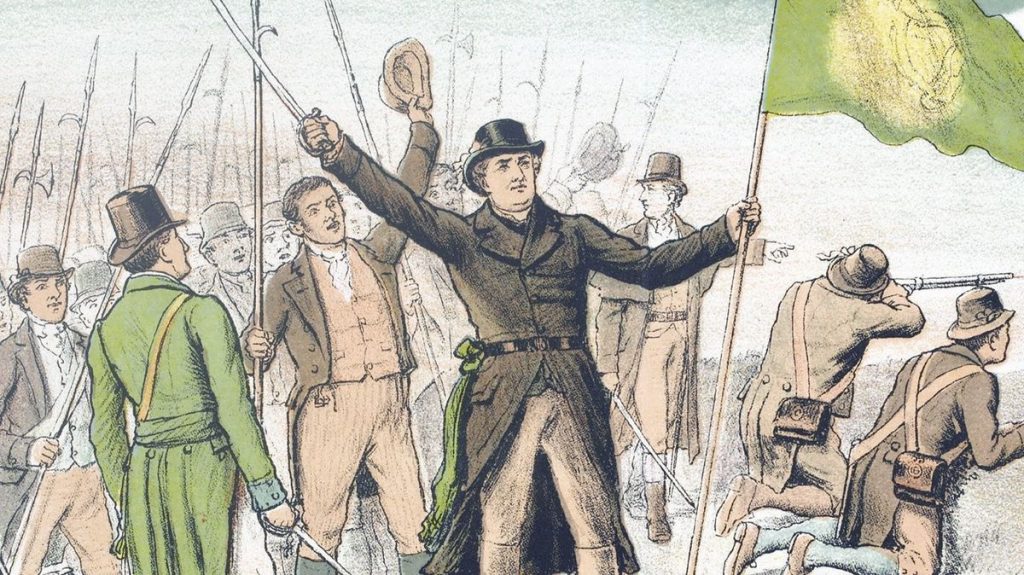 #High. I was also asked to be part of an anthology of short stories edited by Tom Williams (author of
#High. I was also asked to be part of an anthology of short stories edited by Tom Williams (author of 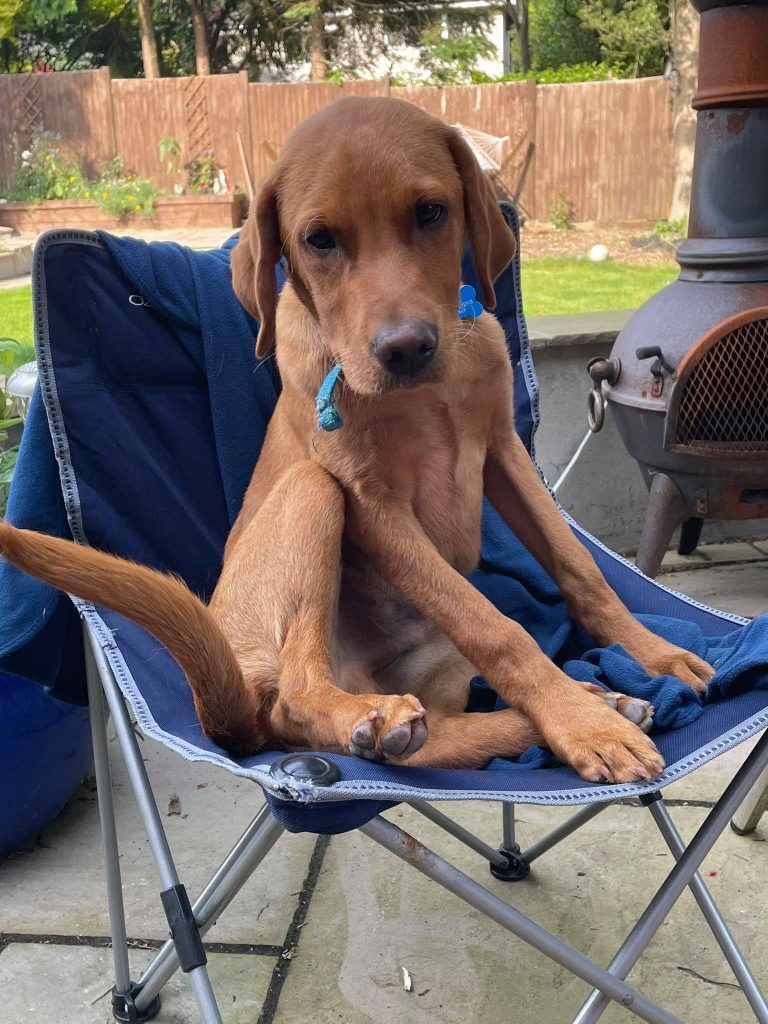 #High.
#High. 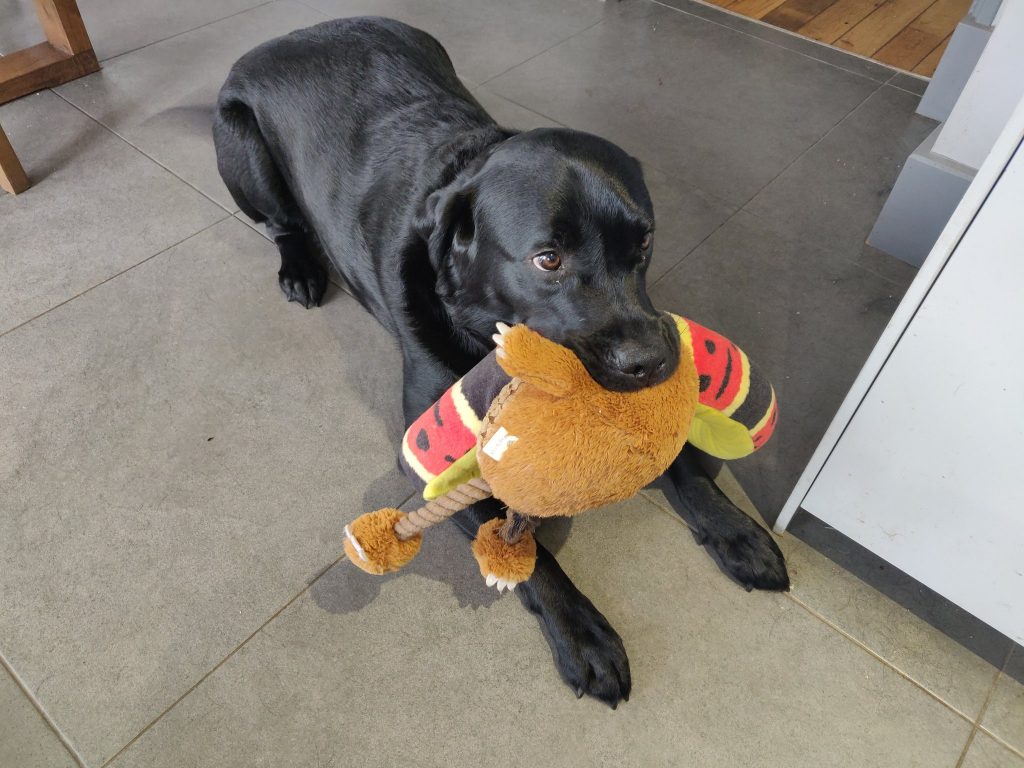 #High.
#High. 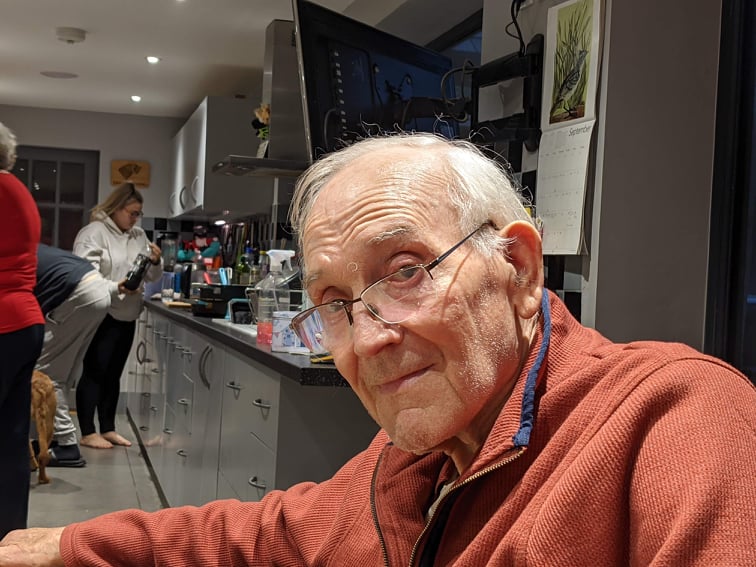 I miss Malcolm. He was only here for a few months, but I got very used to him being around. From the earliest days of my relationship with Richard, almost thirty years ago now, Malcolm and I had a special bond. He shared my enthusiasm for history, and years ago, before I’d ever published, he bought me my first biography of Wellington, the Longford one, from a second-hand book shop. He got on well with my parents, although they didn’t meet that often, and he adored his grandchildren. He loved books and music and was interested in current affairs. He also loved technology, especially cars, and when he was younger, he could fix anything. Before I was even married, he took me for a day out to Silverstone, to watch a Formula One Grand Prix, and we had a fabulous time.
I miss Malcolm. He was only here for a few months, but I got very used to him being around. From the earliest days of my relationship with Richard, almost thirty years ago now, Malcolm and I had a special bond. He shared my enthusiasm for history, and years ago, before I’d ever published, he bought me my first biography of Wellington, the Longford one, from a second-hand book shop. He got on well with my parents, although they didn’t meet that often, and he adored his grandchildren. He loved books and music and was interested in current affairs. He also loved technology, especially cars, and when he was younger, he could fix anything. Before I was even married, he took me for a day out to Silverstone, to watch a Formula One Grand Prix, and we had a fabulous time. Richard and I went to London with a van to collect some of their possessions when we still thought they might make a go of living over here. I rather fell in love with a beautiful collection of wooden boats that Malcolm had in his study and mentioned how much I liked them as we were unpacking. To my surprise and delight, he insisted on giving them to me, to go with my wooden model of the Victory in my study. They look beautiful, and I feel as though there’s a little part of him sharing my workspace still. I’m working on a proper obituary for Malcolm. He had an interesting life, and I’d love to share it with people.
Richard and I went to London with a van to collect some of their possessions when we still thought they might make a go of living over here. I rather fell in love with a beautiful collection of wooden boats that Malcolm had in his study and mentioned how much I liked them as we were unpacking. To my surprise and delight, he insisted on giving them to me, to go with my wooden model of the Victory in my study. They look beautiful, and I feel as though there’s a little part of him sharing my workspace still. I’m working on a proper obituary for Malcolm. He had an interesting life, and I’d love to share it with people.
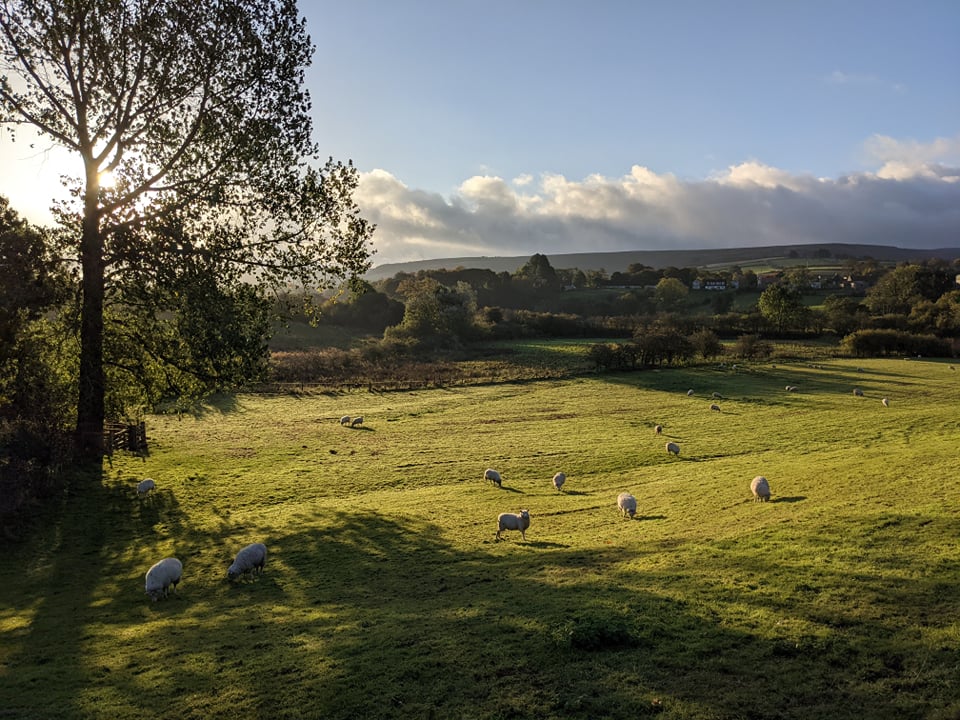
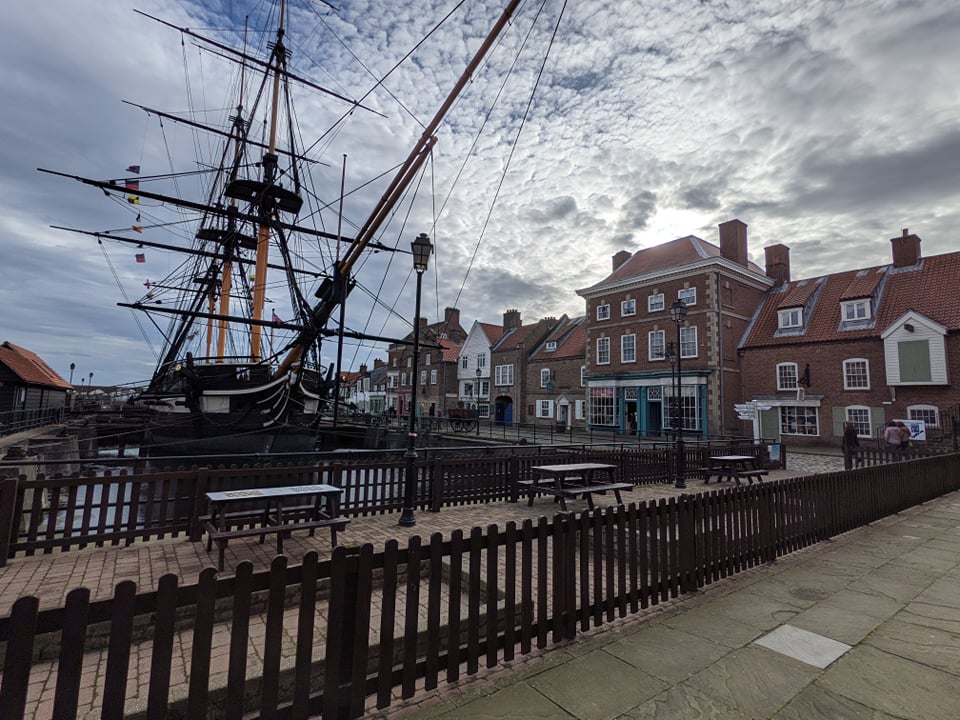
 A cast iron plaque of the Duke was unearthed during restoration work and can be seen on the wall as you go up the stairs. The inn is not large and is very obviously old – floors are uneven and the furniture is very traditional. Impressively, though, all the essential things for a comfortable stay work really well – the bed was comfortable, the bathroom modern and heating and hot water were spot on. I’d booked bed and breakfast, but after a look at the dinner menu, decided I’d eat there in the evening as well. It was standard pub food, but well-cooked and sensibly priced, and I never object to sitting by an open fire in a traditional country pub to eat. In addition, the staff were absolutely amazing. Nothing was too much trouble and they treated my invasion of the guest sitting room as though it was the most normal thing in the world. Thank you so much guys.
A cast iron plaque of the Duke was unearthed during restoration work and can be seen on the wall as you go up the stairs. The inn is not large and is very obviously old – floors are uneven and the furniture is very traditional. Impressively, though, all the essential things for a comfortable stay work really well – the bed was comfortable, the bathroom modern and heating and hot water were spot on. I’d booked bed and breakfast, but after a look at the dinner menu, decided I’d eat there in the evening as well. It was standard pub food, but well-cooked and sensibly priced, and I never object to sitting by an open fire in a traditional country pub to eat. In addition, the staff were absolutely amazing. Nothing was too much trouble and they treated my invasion of the guest sitting room as though it was the most normal thing in the world. Thank you so much guys. I’m pleased to say I stood by my resolution to treat this week as a writer’s retreat. Apart from my one excursion to Hartlepool, I remained in and around the village. The weather was beautiful, crisp and cold but with only one rainy day. I ordered breakfast early then went for a walk every morning before sitting down to work. Lunch was soup and sandwiches from the
I’m pleased to say I stood by my resolution to treat this week as a writer’s retreat. Apart from my one excursion to Hartlepool, I remained in and around the village. The weather was beautiful, crisp and cold but with only one rainy day. I ordered breakfast early then went for a walk every morning before sitting down to work. Lunch was soup and sandwiches from the  During the day I took over the desk and worked solidly on book seven, An Indomitable Brigade. I found, to my joy, that I’d been right about the book. There was nothing wrong with either plotting or the research I’d done. I just needed time, and peace and quiet to get on with it. I kept in touch with my family during the evening, but firmly refused to take calls during the day. I was helped by the fact that the wi-fi was variable. It worked very well in my room, and down in the bar areas but in the study it was patchy, which removed the temptation to chat on Twitter or Facebook. After the first day, I was completely absorbed in the world of the 110th and the battle of Vitoria.
During the day I took over the desk and worked solidly on book seven, An Indomitable Brigade. I found, to my joy, that I’d been right about the book. There was nothing wrong with either plotting or the research I’d done. I just needed time, and peace and quiet to get on with it. I kept in touch with my family during the evening, but firmly refused to take calls during the day. I was helped by the fact that the wi-fi was variable. It worked very well in my room, and down in the bar areas but in the study it was patchy, which removed the temptation to chat on Twitter or Facebook. After the first day, I was completely absorbed in the world of the 110th and the battle of Vitoria. I enjoyed my day out at the National Museum of the Royal Navy in Hartlepool, and the Trincomalee was everything I hoped for and more. The museum is set up around a historic quayside restored to look like an eighteenth century seaport and its beautiful waterside setting. The various buildings are set up to show tradesmen like tailors, printers and instrument makers with stories about the Royal Navy and the men and women associated with it. It’s a great place for kids, with an adventure play ship and loads of activities, and because I was there during half term, there were demonstrations of gunnery and swordsmanship and various talks scheduled through the day. I went to everything, even though most of this wasn’t new to me. It was a great atmosphere, and I thoroughly enjoyed the interactive Fighting Sail exhibition, though the kids commentary around me probably entertained me as much as the displays.
I enjoyed my day out at the National Museum of the Royal Navy in Hartlepool, and the Trincomalee was everything I hoped for and more. The museum is set up around a historic quayside restored to look like an eighteenth century seaport and its beautiful waterside setting. The various buildings are set up to show tradesmen like tailors, printers and instrument makers with stories about the Royal Navy and the men and women associated with it. It’s a great place for kids, with an adventure play ship and loads of activities, and because I was there during half term, there were demonstrations of gunnery and swordsmanship and various talks scheduled through the day. I went to everything, even though most of this wasn’t new to me. It was a great atmosphere, and I thoroughly enjoyed the interactive Fighting Sail exhibition, though the kids commentary around me probably entertained me as much as the displays.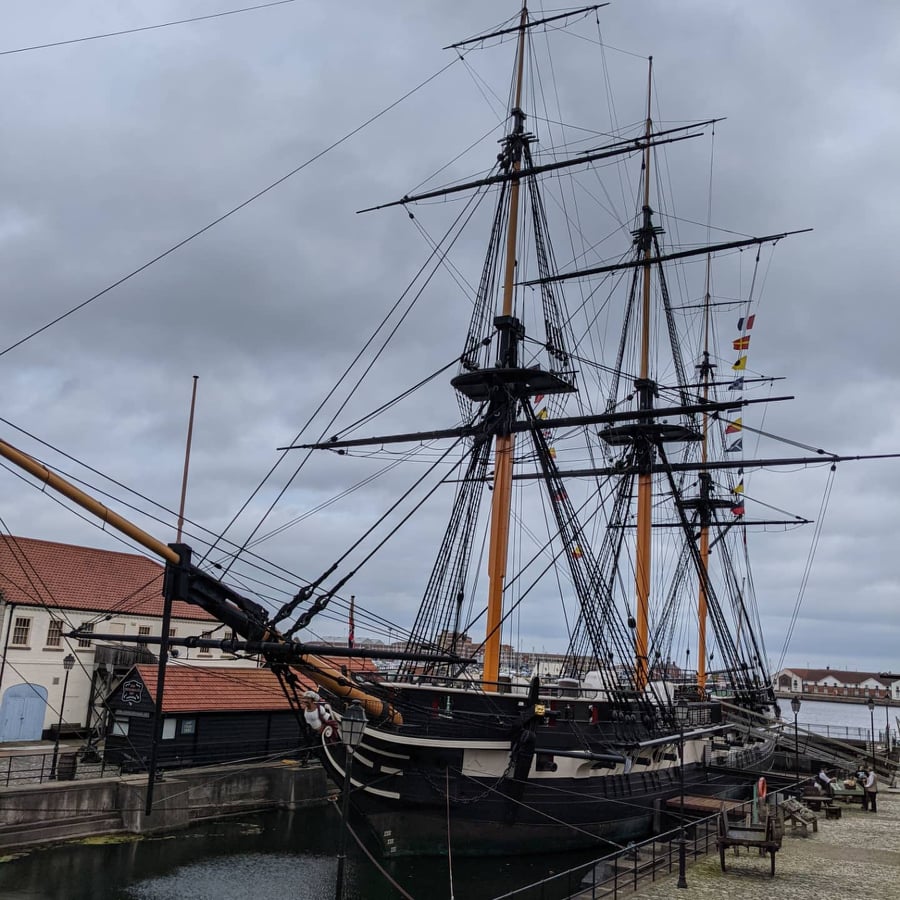 The Trincomalee was perfect, one of two surviving British frigates of her era. The other, HMS Unicorn is a museum ship in Dundee and I’m going to get there when I can. The Trincomalee was commissioned in 1812 to be built in India using teak, due to the shortage of oak in Britain after the intensive shipbuilding of the Napoleonic wars. Work did not begin until 1816 so by the time the ship was finished the following year, the wars were over and Trincomalee was put to other uses.
The Trincomalee was perfect, one of two surviving British frigates of her era. The other, HMS Unicorn is a museum ship in Dundee and I’m going to get there when I can. The Trincomalee was commissioned in 1812 to be built in India using teak, due to the shortage of oak in Britain after the intensive shipbuilding of the Napoleonic wars. Work did not begin until 1816 so by the time the ship was finished the following year, the wars were over and Trincomalee was put to other uses.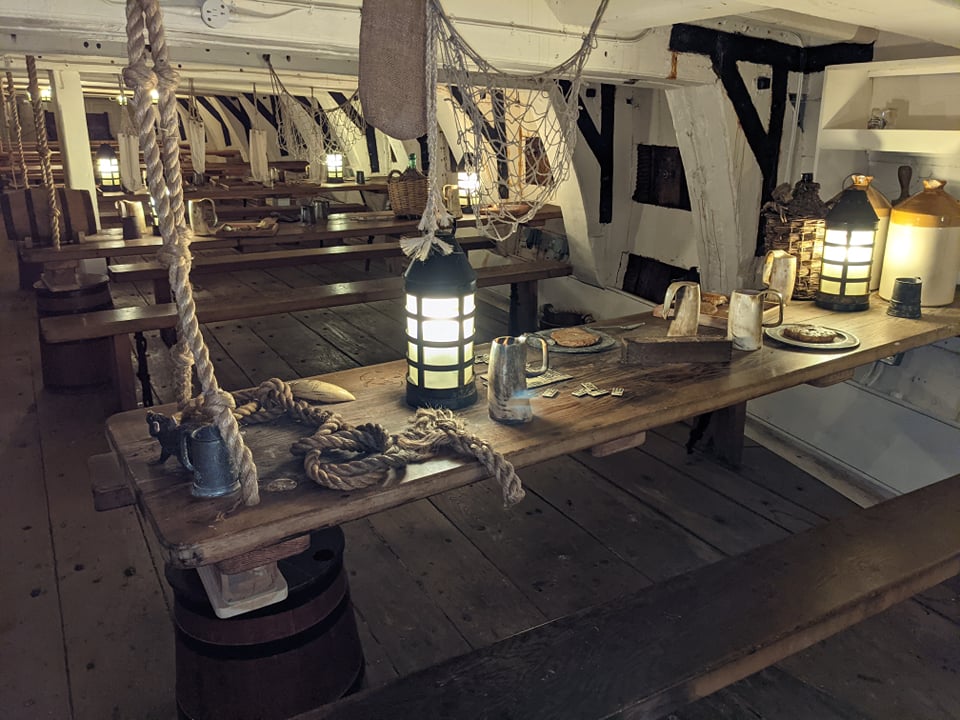 On the advice of one of the guides, I waited until the kids were completely absorbed in learning how to form a boarding party on the quayside using foam swords and cutlasses before boarding the ship. It was completely empty and I was able to take photographs, absorb the atmosphere and write stories in my head to my hearts content. The Trincomalee quickly morphed into the fictional Herne in my imagination, Hugh Kelly’s first post-command, and the story was finished. I’ll definitely come back to it though, I’d like to write a lot more of Hugh’s earlier adventures in the navy.
On the advice of one of the guides, I waited until the kids were completely absorbed in learning how to form a boarding party on the quayside using foam swords and cutlasses before boarding the ship. It was completely empty and I was able to take photographs, absorb the atmosphere and write stories in my head to my hearts content. The Trincomalee quickly morphed into the fictional Herne in my imagination, Hugh Kelly’s first post-command, and the story was finished. I’ll definitely come back to it though, I’d like to write a lot more of Hugh’s earlier adventures in the navy.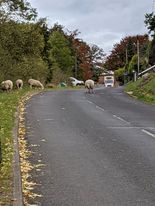
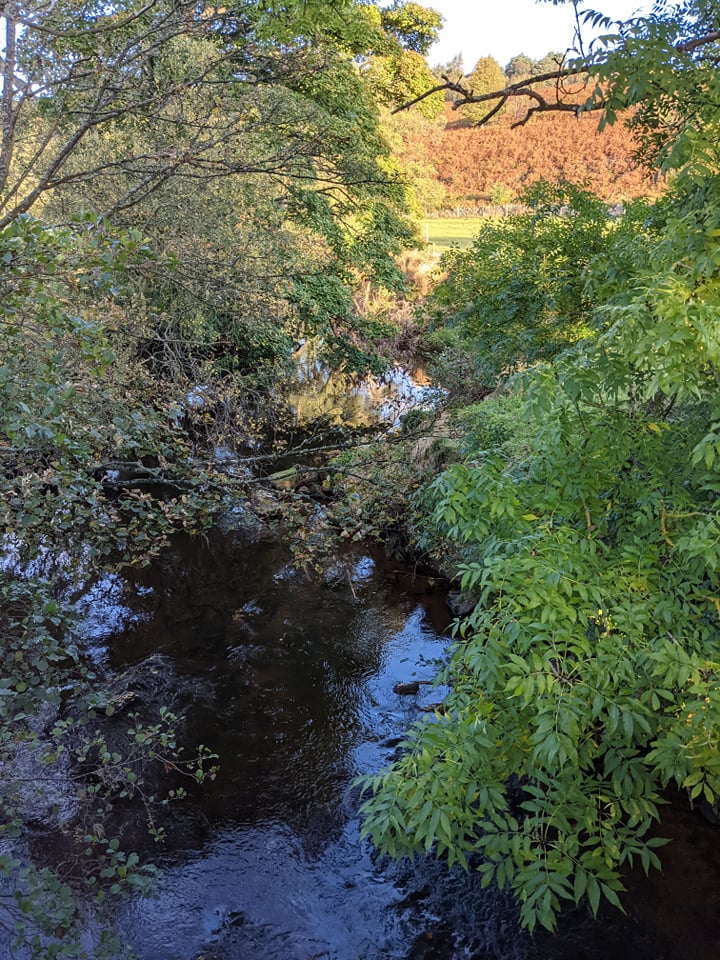 I’ve concluded that a writer’s retreat means different things to different people. For some, it’s about learning, and they’re looking for lectures and workshops and the ability to try something new. For others, it’s about connecting with other writers to share ideas and stories and to feel part of a community for a while, in this very solitary job that we do. For me, it’s definitely a retreat, a place of quiet and solitude and some beauty, where I can throw myself back into what I do best without any nagging sense of all the other things on my to do list.
I’ve concluded that a writer’s retreat means different things to different people. For some, it’s about learning, and they’re looking for lectures and workshops and the ability to try something new. For others, it’s about connecting with other writers to share ideas and stories and to feel part of a community for a while, in this very solitary job that we do. For me, it’s definitely a retreat, a place of quiet and solitude and some beauty, where I can throw myself back into what I do best without any nagging sense of all the other things on my to do list.
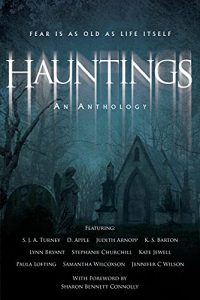 Hauntings: an interview with D Apple
Hauntings: an interview with D Apple
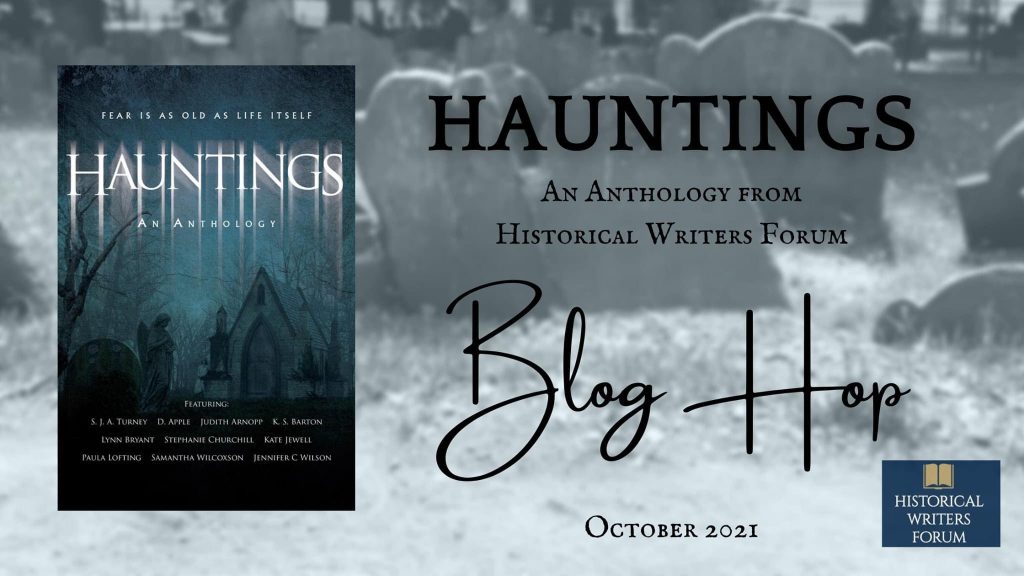

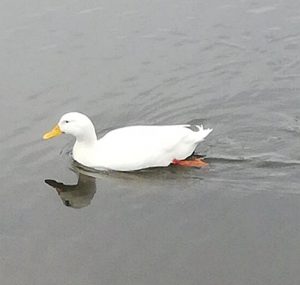 It’s been very quiet here at Writing With Labradors, but I’m delighted to tell you that I’m kicking off a new season of blog posts with Angry White Popham Duck II.
It’s been very quiet here at Writing With Labradors, but I’m delighted to tell you that I’m kicking off a new season of blog posts with Angry White Popham Duck II. Since the arrival of
Since the arrival of 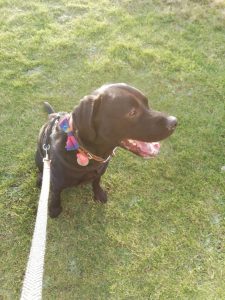
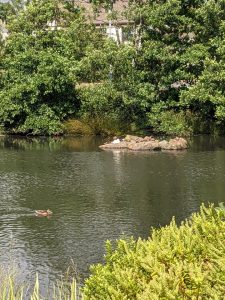 As we arrived at the pond, it was very quiet. There weren’t even any kids in the play park, I’ve no idea where everybody was this afternoon. I approached the edge of the main pond very carefully, and there he was. Initially, he was sitting on Duck Island dozing with his friends, but Popham Duck has a special dog warning sensor (probably invented by him, and better than all other dog warning sensors, because he’s a genius) and was very quickly in the water and swimming towards us to check us out.
As we arrived at the pond, it was very quiet. There weren’t even any kids in the play park, I’ve no idea where everybody was this afternoon. I approached the edge of the main pond very carefully, and there he was. Initially, he was sitting on Duck Island dozing with his friends, but Popham Duck has a special dog warning sensor (probably invented by him, and better than all other dog warning sensors, because he’s a genius) and was very quickly in the water and swimming towards us to check us out. Popham came on. It was very clear that he had seen the lurking dogs. Alfie’s tail was wagging furiously, but he said nothing. I was holding my breath. Most puppies will bark when they see a new creature, out of sheer excitement. Alfie couldn’t take his eyes from Popham but he still made no sound. He glanced sideways at Oscar a few times, maybe for reassurance. Oscar was his usual calm self and it worked. Alfie watched Popham for a bit longer then settled down for a rest.
Popham came on. It was very clear that he had seen the lurking dogs. Alfie’s tail was wagging furiously, but he said nothing. I was holding my breath. Most puppies will bark when they see a new creature, out of sheer excitement. Alfie couldn’t take his eyes from Popham but he still made no sound. He glanced sideways at Oscar a few times, maybe for reassurance. Oscar was his usual calm self and it worked. Alfie watched Popham for a bit longer then settled down for a rest.
 It wasn’t until we walked further round the pond, that Popham gave a few quacks. They were nothing like his usual aggressive yelling. It was more like a friendly warning not to get too close. And I could suddenly see why. There were ducklings, swimming frantically around their mother.
It wasn’t until we walked further round the pond, that Popham gave a few quacks. They were nothing like his usual aggressive yelling. It was more like a friendly warning not to get too close. And I could suddenly see why. There were ducklings, swimming frantically around their mother.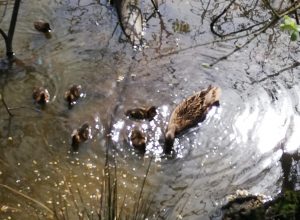 “Popham, is it you making that racket?”
“Popham, is it you making that racket?”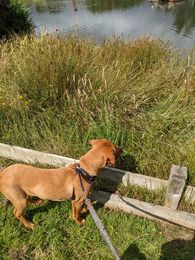 Whatever the story, it was certainly a pleasant introduction to the duck pond for Alfie. It was quite a long walk for him at this stage, and on a warm afternoon as well.
Whatever the story, it was certainly a pleasant introduction to the duck pond for Alfie. It was quite a long walk for him at this stage, and on a warm afternoon as well.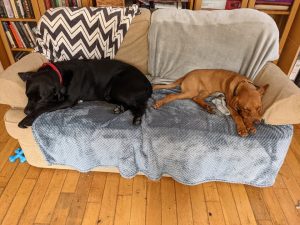 “Looks as though Alfie is taking a nap before dinner. I might just join him…”
“Looks as though Alfie is taking a nap before dinner. I might just join him…”
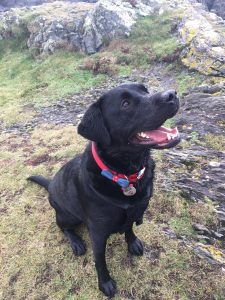 “Today I am giving command of Writing with Labradors to our newly promoted officer, Captain Oscar so that he can post his very own Welcome to Alfie. Oscar, are you ready?”
“Today I am giving command of Writing with Labradors to our newly promoted officer, Captain Oscar so that he can post his very own Welcome to Alfie. Oscar, are you ready?”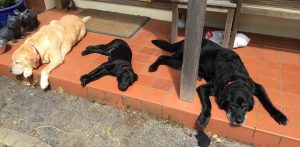 I’ve done a few posts now, as part of our very popular
I’ve done a few posts now, as part of our very popular  Nobody told me just how exciting this homecoming was going to be. Rachael-human went off to pick Anya up in her car, which meant it was very quiet for a few days. But when they arrived…OMG WHAT A SURPRISE!!!
Nobody told me just how exciting this homecoming was going to be. Rachael-human went off to pick Anya up in her car, which meant it was very quiet for a few days. But when they arrived…OMG WHAT A SURPRISE!!!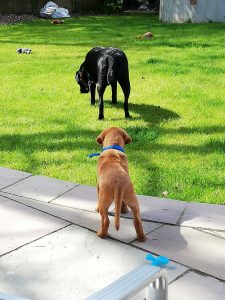 Of course, being a big brother brings new responsibilities. I can remember
Of course, being a big brother brings new responsibilities. I can remember  I don’t think we’ll get much sense out of Oscar for a bit. He and Alfie seem to be getting on very well, and I have a feeling that Writing With Labradors is in good hands for the future. Or rather, good paws. We’ve all settled down for a rest now, although it isn’t clear how much of her essay Anya is going to get done today.
I don’t think we’ll get much sense out of Oscar for a bit. He and Alfie seem to be getting on very well, and I have a feeling that Writing With Labradors is in good hands for the future. Or rather, good paws. We’ve all settled down for a rest now, although it isn’t clear how much of her essay Anya is going to get done today. We’re fully staffed again here at Writing With Labradors and while we have a bit of work to do training the new recruit, having two dogs in my study with me while I’m working feels very right. Expect many more photos and videos as the boys settle down together and really bond as brothers.
We’re fully staffed again here at Writing With Labradors and while we have a bit of work to do training the new recruit, having two dogs in my study with me while I’m working feels very right. Expect many more photos and videos as the boys settle down together and really bond as brothers.